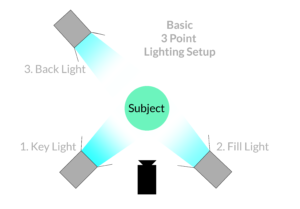Best Budget Lighting Tricks for Your Videos
If you’re not taking advantage of video marketing, you’re likely behind the curve, because by 2021 it’s anticipated that 80 percent of internet traffic will be video.
Video is a powerful way to raise brand awareness, promote your product, grow your business online and increase sales.
We can talk about all the reasons why video marketing is the bomb, but let’s take a look at what goes into making a good video. One of those key elements is lighting.
Lighting sets the mood. And lighting can also be one of the most difficult aspects of shooting high-quality video. You have the camera, the script and the talent, so don’t ruin your video with poor lighting. What are few of the best and simplest lighting tricks for lighting your subject on camera?
Use Natural Lighting if You’re Outside
If you plan to shoot outside using natural elements and landscapes, you’ll want to know where the sun is in relation to your subject. You generally place the person in the video between you and the sun.
Depending on the kind of ambience you want to create, conventional wisdom says to keep the sun behind you in harsh sunlight; otherwise, you’re casting harsh shadows on the subject. If you’re going for the halo effect, however, you’d shoot into the sun — something you might see in wedding photos, for example. Shooting in the morning, early evening or on cloudy days may be a better bet for a crisper, cleaner video in a natural setting.
Knowing how to use lighting to your advantage, whether for a marketing video or even a selfie, is going to help you achieve the best shots.
There’s a lot more to shooting video outside than meets the eye.
Here is what you need to know:
If You’re Inside and Don’t Have Equipment
You can still use natural lighting to your advantage indoors. If there’s a window, use the light coming in, especially if your video is looking dark and dreary. If you don’t have windows or it’s nighttime, turn on as many lights as possible or bring in a floor lamp; just don’t use yellow light. “White lights are the best,” says digital media strategist Brian Peters at Buffer.
If it’s too bright or harsh with the window sunlight, place a sheer curtain or blanket over the window to diffuse the light coming in. As is the case with shooting outside, pay attention to where the light is hitting the subject. Avoid casting shadows on faces and make sure direct light is shining on the subject — not just in the area in front, behind or around them.
No one said lighting has to be overly complicated or expensive!
If You’re Inside and Have Basic Equipment
A three-point light setup is probably the most traditional lighting configuration indoors. It ensures you have enough light to get the job done properly.
3-Point Lighting Set up. Image from clipchamp.
A three-point lighting setup consists of … three lights. Specifically, you’ll need extension cords, three clamp lights, three light stands and bulbs. Here is how the setup works.
Key Light: Place it in front of the talent (or subject) at a 45-degree angle. Raise the light above the talent’s head and point it down on them. Make sure it is bright enough so that it could serve as the only light bright enough for the scene.
Fill Light: The second light will be placed to the other side of the subject. It will also be at a 45-degree angle but it will be pointed at just about eye level. This is the fill light, which means it will be slightly dimmer than the key light. Move it back and clip diffuser paper or even an opaque shower curtain over the lamp with clothes pins to diffuse the light.
Backlight: The third light is the backlight aimed at the back of the talent’s head. It creates a subtle glow that separates the talent from the background. Turn down all overhead lights to reduce any flares.
I'd recommend the Neewer 3 Piece LED Video Light Kit which is an excellent starter video kit for just $279. This lighting kit uses bi-color Ultra High CRI 96+ LED lights which produces the highest quality and most flattering light possible that does not overheat. The kit also comes with three 75 inch light stands. You can also consider buying batteries for these lights to use them outside or in spaces where outlets are not available.
When it comes to shooting a good-looking marketing video, you’ll have to experiment with all of the different lighting options available to you. Some companies don’t have the resources to buy equipment, so they’ll have to work with natural or indoor lighting to the best of their ability. I've put together this list of budget lighting options that you can choose from.
Lighting can make or break the video, so spend the extra time figuring out what’s going to work best for your needs. If, in post production, your lighting looks insufficient, you could use video editing tricks via Premiere Pro, Final Cut or Avid to enhance the visual quality of your marketing material. What are your tips for quality video lighting?


